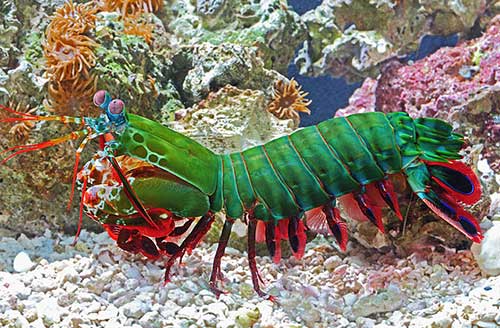Eyes of Nature
Five Animals With Fascinating Eyes

According to scientists, eyes evolved around 540 million years ago as simple light detecting organs. Through evolution, these organs have become complex and an important tool for many animals, humans included. Here are some of the strangest and most incredible eyes in the animal kingdom.
5: The Four Eyed Fish
Found in Mexico and Central America, as well as Northern South America, these are small fish feed mostly on insects, so they spend most of their time swimming at the surface. Despite their name, four eyed fish have only two eyes. However, these eyes are divided by a band of tissue and each half of the eye has a pupil of its own. This unusual adaptation allows the four eyed fish to see perfectly both above and below the waterline, at the same time! Although both halves of the eye use the same lens, the thickness and curve of the lens is different in the upper and lower eye halves, giving the fish great vision both in and out of the water.
4: The Stalk Eyed Fly
These small yet spectacular creatures are mostly found in the jungles of South East Asia and Africa, with a few species that can be found in Europe and North America. Their name comes from the long stalk which stems from the sides of the head, holding their eyes. During mating season, males often stand face to face to measure their eyestalk’s length. The one with the greatest “eye span” is recognized as the winner. As an adaption to this mating ritual, male flies have an extraordinary ability to enlarge their eyestalks by ingesting air through their mouth and pumping it through ducts in the head to the eyestalks. Here’s an amazing video of the male stalk eyed fly, emerging from its cocoon and enlarging his eyestalks.
3: Spookfish
The spookfish is a deep water, almost ghostly-looking fish that has some of the most bizarre eye structures known to science; each eye has a lateral swelling called a diverticulum, separated from the main eye by a septum. While the main part of the eye has a lens and functions in a similar way to other animal eyes, the diverticulum has a curved, composite mirror made up of many layers. This “mirror” can gather far more light than the normal eye, allowing the fish to see both up at down at the same time. Spookfish are found worldwide but are rare. Since they spend most of their lives at a depth of 1000-2000 meters, it is unlikely to ever see one.
2: Chameleons
Although chameleons are most famous for their ability to change color, these lizards also have very unusual eyes. Chameleons have eyelids that are fused, and therefore cover almost the entire eyeball. Only a small opening hole is featured to let the pupil see through. Additionally, each eye can be moved independently from the other, allowing the animal to scan for prey and potential threats at the same time. This also means that the chameleon has a full 360-degree field of vision. When the chameleon sees a potential prey, it can focus both eyes in the same direction, gaining stereoscopic vision allowing prey to be captured by shooting out its tongue at high speed, a technique that requires a very precise depth perception. Chameleons have very sharp eyesight, being able to see an insect several meters away and see ultraviolet light.
1: Mantis Shrimp (pictured)
Last, but certainly not least, we have reached the animal with the weirdest and most amazing eyes in the world. Despite the name, the mantis shrimp is not actually a shrimp, rather it is a crustacean from the Stomatopoda order. Known for its aggressiveness and formidable weaponry, mantis shrimp have extremely sharp and powerful claws that can split a human finger in two. Much like the dragonfly, mantis shrimp have compounded eyes. Mantis shrimp have much better color vision than humans. While the human eye only contains three color receptors, mantis shrimp have 12—as well as ultraviolet, infrared, and polarized light vision! This gives these crustaceans the title of the most complex eyesight of any animal known. Their eyes are located at the end of stalks, and can be moved independently from each other, rotating up to 70 degrees.
Continuing with their weirdness; each of the mantis shrimp’s eyes is divided in three sections. This allows the creature to see objects with three different parts of the same eye. In other words, each eye has “trinocular vision” and complete depth perception. Hypothetically, if a mantis shrimp lost an eye, its remaining eye would still be able to judge depth and distance just as well as a human with two eyes. Scientists are only starting to understand the mysteries of Stomatopod vision; for the moment, we can only imagine what the world really looks like to a mantis shrimp.

